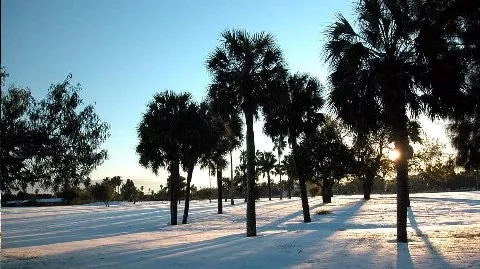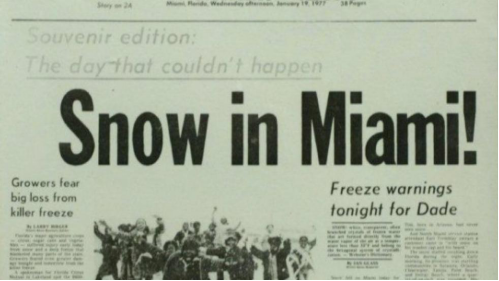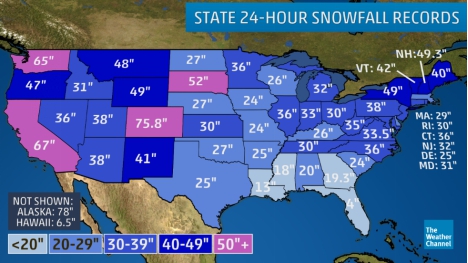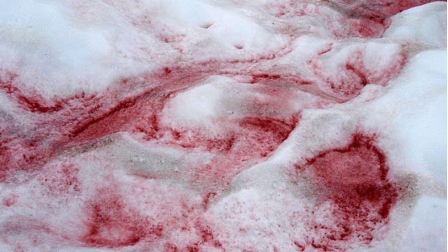View Other Topics.
 Apr 5, 2017
Apr 5, 2017
Whether you are singing about snow or hoping that summer would come back says the Weather Channel, winter storms are on the way in the not too distant future.
Here are 10 things you may not know about wintery precipitation.
Brownsville, Texas, recorded 1.5 inches of snow on Christmas Day 2004. This is that city's only measurable snowfall dating back to 1895.
In 1977, it snowed in Miami and Homestead, Florida, dusting cars and palm trees in tropical Dade County. This was not a measurable amount, and the history books list this snow as a trace. Key West has never seen snow.

Thirty-five years ago, on Jan. 19, 1977, snowflakes briefly dusted palm trees,
windshields and people from Miami to West Palm Beach.(Naples Daily News)
The Weather Channel
You might also be surprised to learn that Hawaii sees snow every year, and even more so, that snow can fall in Hawaii in any month. As you would expect, the snow that falls in Hawaii is confined to its highest elevations, including Mauna Loa and Mauna Kea on the Big Island along with Haleakala on Maui Island.
For snow to occur at temperatures above 40 degrees, the humidity has to be very low, because as snow falls, the flakes evaporate and cool. Evaporation is more efficient when it is dry.
On rare occasions, snowflakes as large as dinner plates have been observed, according to Kenneth G. Libbrecht, a professor of physics at the California Institute of Technology.
The largest individual snow crystal ever observed by Libbrecht was 0.4 inches from tip to tip.

Elsewhere in the United States, Alaska received 78 inches in 24 hours at Mile 47 Camp in north-central Alaska in 1963. The Weather Channel
7. Snow Isn't Always White
Snow is actually translucent and reflects upward of 90 percent of light that reaches the surface of the snow. Very little light is absorbed in snow, and no particular colors are absorbed more than others. This is the reason snow appears bright white, especially as it is falling.
In fact, naturally accumulating snow can appear blue or even pink. Just like in glaciers, deep snow can attain a deep blue hue as red light gets trapped in deeper pockets of snow. The deeper the snow is, the bluer it can become.
In some higher terrain, snow can be pink due to algae that grows there.

Pink snow is commonly referred to as watermelon snow by locals.
The Weather Channel
To see some of these types, check out the slideshow below.
Image: South Texas' White Christmas 2004) - The Weather Channel
Tags:
#snow,#unusual#snowfalls,#snow#is#a#mineral,#snow#storm,#weather,#starzpsychics.con,#starz#advisors
10 Facts About Snow That Might Surprise You.

Whether you are singing about snow or hoping that summer would come back says the Weather Channel, winter storms are on the way in the not too distant future.
Here are 10 things you may not know about wintery precipitation.
1. It Has Snowed as Far South as San Diego and Miami ... and Hawaii
The city of San Diego has had numerous reports of snow flurries, accumulating to a trace on two occasions. Los Angeles has recorded accumulating snow on three occasions, including up to 2 inches in 1932.Brownsville, Texas, recorded 1.5 inches of snow on Christmas Day 2004. This is that city's only measurable snowfall dating back to 1895.
In 1977, it snowed in Miami and Homestead, Florida, dusting cars and palm trees in tropical Dade County. This was not a measurable amount, and the history books list this snow as a trace. Key West has never seen snow.

Thirty-five years ago, on Jan. 19, 1977, snowflakes briefly dusted palm trees,
windshields and people from Miami to West Palm Beach.(Naples Daily News)
The Weather Channel
You might also be surprised to learn that Hawaii sees snow every year, and even more so, that snow can fall in Hawaii in any month. As you would expect, the snow that falls in Hawaii is confined to its highest elevations, including Mauna Loa and Mauna Kea on the Big Island along with Haleakala on Maui Island.
2. It Can Snow at Temperatures Well Above Freezing
It has snowed at over 40 degrees on numerous occasions, at the surface. Theoretically, according to ScienceBits.com, it can snow up to around 46 degrees.For snow to occur at temperatures above 40 degrees, the humidity has to be very low, because as snow falls, the flakes evaporate and cool. Evaporation is more efficient when it is dry.
3. Snow Is a Mineral
According to the National Snow & Ice Data Center, snow is a mineral because it is a naturally occurring solid, inorganically formed, and has a definite chemical composition.4. Snowflakes as Large as Dinner Plates?
Individual snow crystals are small, but sometimes they stick together and create a much larger snowflake.On rare occasions, snowflakes as large as dinner plates have been observed, according to Kenneth G. Libbrecht, a professor of physics at the California Institute of Technology.
The largest individual snow crystal ever observed by Libbrecht was 0.4 inches from tip to tip.
5. In the Lower 48, Colorado Holds the Record for Most Snow to Fall in a 24-Hour Period
Silver Lake, Colorado, received 75.8 inches of snow in a 24-hour period back in 1921.
Elsewhere in the United States, Alaska received 78 inches in 24 hours at Mile 47 Camp in north-central Alaska in 1963. The Weather Channel
6. Not Every Windy Snowstorm Is a Blizzard
According to the National Weather Service, blizzard conditions are met when sustained winds of 35 mph or greater last for three hours or more, and visibility is reduced by falling or blowing snow to less than a quarter-mile frequently for the same period of time.7. Snow Isn't Always White
Snow is actually translucent and reflects upward of 90 percent of light that reaches the surface of the snow. Very little light is absorbed in snow, and no particular colors are absorbed more than others. This is the reason snow appears bright white, especially as it is falling.
In fact, naturally accumulating snow can appear blue or even pink. Just like in glaciers, deep snow can attain a deep blue hue as red light gets trapped in deeper pockets of snow. The deeper the snow is, the bluer it can become.
In some higher terrain, snow can be pink due to algae that grows there.

Pink snow is commonly referred to as watermelon snow by locals.
The Weather Channel
8. Snowflakes Can Be the Same
In 1988, a scientist at the National Center for Atmospheric Research (NCAR) found two identical snow crystals. Similar results have been produced in laboratories. Did we really think that of the infinite amount of snow produced around the world each year, no two flakes are identical? That seems improbable.9. There Are Many Forms of Snow
When we think about snow, most of us think of the beautiful dendrites. According to snowcrystals.com, there are at least 35 types of snowflakes.To see some of these types, check out the slideshow below.
10. The Biggest Snowball Fight Was in ...
Saskatoon, Canada. More than 7,600 winter warriors came out to throw snow at each other on Jan. 31, 2016.Image: South Texas' White Christmas 2004) - The Weather Channel
Share this article with friends!
Tags:
#snow,#unusual#snowfalls,#snow#is#a#mineral,#snow#storm,#weather,#starzpsychics.con,#starz#advisors






